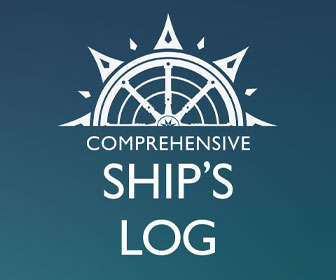French Polynesia, Tuamotos, Apatiki Carenage: Cruisers share their experiences
See more current comments at bottom of the report.
Published 10 years ago, updated 5 years ago
Report from Robert Grant of SY Chance – 22 June, 2012
Visit to Apataki Carenage – April 2011
South Pass of Apetaki: The maximum draft limitation on entering the shallow harbor to the west of the wharf is 1.8m (according to locals). There is no longer swinging room due to mooring buoys.
Owners of Carenage: Alfred and Pauline Lau. Their son, Tony, handles slipping operations, equipment hire etc. and is careful and helpful.
Moorings: (5 at time of writing). Free. The 2 we were on consisted of suspended down chain and cats-cradle of chains & odd shackles around a coral head. Be prepared for 5’ seas if the wind is in the north-west. In these conditions we deployed an anchor in addition, as most of the moorings are close to other coral heads.
Haul out: The carenage agreed to haul us at 2.10m draft (10cm over that stated in website). To assist, we arrived at our notified ETA at the top of Springs. Due to other boatyard commitments, they were unable to haul us for 4 days after High Water Springs. At the nominated time we touched on the trailer, only to be told to come back the next day as we were too deep by some measure. Next day (with even less tide height), Tony blasted away with an underwater Karcher until we floated on to the trailer.
Haul out is by “Parklev” trailer, using a common 70hp front end loader with backhoe. The prime mover provides hydraulic power to operate the trailer rams etc. The pads on the trailer consist of two large pads aft and a ‘V’ pad arrangement forward for monohulls. This forward pad, on our conventional fin keel hull, produced locker jamming high local loading as it did not, by its design, lend itself to conforming to our hull shape and had minimum load area. The backhoe was used to haul the loaded trailer over a “hump” in the runway, by hooking the ripper claws into a bight of chain attached to wire anchored in the earth. Given the poor state of maintenance of the prime mover and the attachment, this arrangement gave us (at 10t displacement) some concern. We witnessed this chain fly off the claws whilst slipping a heavier monohull, causing some loss of control.
Hardstand: Well laid out in crushed and small coral top surface, on earth. Access ladders were new aluminium. Check planks and trestles closely before use. We stood in the yard with nine adequate supports driven into the ground with plywood pads and wedges to the boat.
Pests: The area is infested with sand flies and mosquitoes and was very hot with little breeze. Rats were seen, as there is a copra drying operation adjacent to the hard standing. We lowered our ladder at night.
Equipment: We hired the Karcher, a standard 14mm Makita sander/polisher, orbital sander and a Makita polisher. All of which were fine.
We ordered and paid for antifouling in advance. On arrival, an attempt was made to pass off 12 litres as 3 months old, when in fact, by the batch number on the rusty cans, it was over 3 years old. Ameron (USA) uses a 9 digit/alpha code. First 2 #’s = month. First letter = year. (V-2011, U=2010, T=2009 etc). So 01V20735A = January 2011.
Facilities:
– One flushing toilet – at peak capacity during our visit queues were forming.
– Showers – dipping from a barrel in the open or by what you could arrange on board.
– Power – provided most nights by generator 1800-2000 approx. and at other times by request.
– Water – power needed for non-potable water, via hose. Drinking water obtainable by jug from rainwater tank whilst we were out of the water.
– Groceries – only store is at the village at Niutahi at the south pass.
– Slipway shop – brushes, rollers, roller covers, paint buckets (not trays), epoxy, thinners, discs etc. Some items were expensive.
– Laundry – 800CFP (about $8) per small load – wash only – take your own soap.
– Internet – unavailable.
– Swimming in the lagoon is free.
Charges: As advertised for carenage & hard stand. However, we were surprised to see a charge for $75 for a night on the trailer, (prior to launch at 0900hrs next day) and an un-itemized bill for extras. From the itemized version we were able to strike off several charges. We paid by credit card.
Be aware: In order to minimize our launching draught, we took no carenage drinking water during our two-week stay. When we came ashore to take 270lt rainwater from the full tank, we were astounded to find that, having left the slipway, we were expected to pay for the water.
Report from Colin Price of SY Pacific Bliss – 21 May, 2012
We recently hauled out at Apataki Carenage in the Tuamotos.
For those who need a haul out, this is the most brilliant yard in a beautiful location. There are limitations on the boat size that they can lift using their hydraulic trailer (new in 2009): Max lift weight 20 tonnes and max draft 2.2 metres.
The family here are super helpful, they have a shop with all the basic paints and rollers etc., and spare parts can be flown in from Tahiti easily. Water and electricity available.
Meals can be arranged if required.
It is a do-it-yourself yard, but I believe that work can be organized if required.
They have a buried-chain system for boats laying up for the cyclone season.
It is the cheapest yard in FP (where nothing is cheap).
Report from Reini Gelder of SY Ave Gitana – 15 June, 2011
I want to inform all sailors that there is a new haul out/ antifouling /yard/ boat storage facility in the Tuamotos in the Atoll of Apataki, in one of the most beautiful and safe environments you can imagine.
The chariot/carriage can handle Yachts – Mono and Multihulls – up to 20 tons, 2-meter draft and up to 14 m(!) beam. We hauled our boat there 14 days ago and were very satisfied with the professionalism and quality of service.
Family Lau who operate the yard are very nice and helpful in any matter. They also operate a small restaurant and a pearl farm. The climate in the Tuamotos is very dry which makes the yard also a good place for long term storage. Cyclones are very rare in this area of French Polynesia, especially during El Nina years. The big Motu where the yard is located is exceptionally high, being up to almost 5 meters above sea level.
The drawbacks of the place are possibly its remoteness, although antifouling and all the other things (including electrical tools) you need for this job are available in the yard. If you want to do a bigger job on your boat, you can order anything from Tahiti and heavy items are shipped every two weeks by cargo vessel. To get to the airport of Apataki is a 1-hour boat ride through the beautiful lagoon that is fully navigable in good light conditions. There are only a few coral heads. On the west side, there are two deep passes into the lagoon, the northern one is easy. Flights to Tahiti Airport are 3 times/week.
The boatyard has a website: www.apatakicarenage.com for more information, or contact:
Tel: (+689) 727 813 / (+689) 714 529
Fax: (+689)829 183
E-mail: [email protected] or [email protected]
Pauline Lau speaks fluent English.
The customs regulations for French Polynesia allow boats to stay up to 2 years without being taxed. When the boat is stored and the owner leaves the country this time is interrupted and extended.
Related content
Related to following destinations: Apataki, French Polynesia, Tuamotus







Comments from s/v Quixotic 2010 (as relayed by Nakia)
I just wanted to let you know that we’ve hooked up with our friends, Ed and Nila, on the catamaran Quixotic. They hauled out at Apataki to travel by camper van in New Zealand last season. They concur that the people are friendly and want to be very helpful BUT there were major issues over the final bill and it turned unfriendly very fast. A couple of the issues were:
•
Thinking he would throw some extra business to the nice family, Ed hired Tony
(Alfred’s son) to assist him with some fiberglass work. That labor (which was very spotty and slow) ended up costing him $50/hour! Ed didn’t keep close track of Tony’s hours and feels the bill was padded in that area.
•
There is some sort of a price break for hauling out before a certain date, which Q
planned to do. However, it was very windy on the appointed date and everyone agreed it would be best to wait a few days. Alfred assured them (but not in writing) that he would honor the special rate.
Come the splash date, with the boat raised off the jack stands, and it was time to settle the bill. When Ed disputed some of the charges, Alfred refused to splash the boat until he was paid in full. All of this was very disheartening because Ed and Nila truly enjoyed their stay in Apataki and had good relations with everyone up until it came time to pay the bill.
They recommend getting everything in writing (even if you have to write it up yourself and have Alfred/Tony sign it) and keeping close track of every detail. They circumnavigated the atoll and thought it was lovely. Oh, and FYI, they found bottom paint cheaper to buy in French Polynesia that it would have been in NZ.
A couple of more data points for Apataki from Ed and Nila
•
There is a $40/day liveaboard fee even if you don’t use their water or electricity.
Quixotic reports that another cruiser installed a handle on the door to the outdoor bathroom, Q provided the TP and something from which to hang it, and there is no shower completed yet (we saw it still very much a work in progress). There are also no bungalows or anywhere to rent a room if you had guests or didn’t want to live on the boat (the web site description is overzealous with what’s actually available).
•
They were charged $30 to ride with the family on their periodic trips to town for provisions. The daughter in Papeete who handles orders for supplies charges
$50/hour for her services and this was not split between boats as Quixotic thought it would be when two or more boats were ordering from the same chandlery.
Bottom line again:
get everything in writing, and maybe pay in advance to get the “in
full” price locked in, to avoid any surprises on your return.
We like to share our experience with Apatiki Carenage.
We brought our yacht, an Endeavour 42 in 2013 to Apatiki to do Antifouling and other repairs ourselves. Because of heavy wind and the fact that there are many coral blocks around the place where the boats are lifted out, we decided to wait for better weather and stayed anchored for almost 3 weeks. These were nice weeks, even though we could not use any power of Apataki Carenage for the purpose of welding. We had a good time with him and his family, playing music on some evenings and felt very welcome.
When the weather got better we decided to haul out. At that point in time, we trusted that Alfred and his team are competent and know what they do. So it was more out of curiosity than any concern that we watched the process of hauling out. A lifting carriage is moved under the boat and four hydraulic cylinders lift up the boat.
A tractor/dredger is used to pull it out. During the lifting up we heard the sound of bent fiberglass and we saw that at one hydraulic lifter the hull is bent inside heavily and about to burst! We screamed stop and the yacht was placed back into the water. Luckily, the hull did not break through but the bending inside did not come back to the original form. A large dint stayed in the hull.
So it was clear that the structure is damaged and extensive repair is required which cannot be done in Apatiki. As soon as possible we left for Tahiti. In Papeete, we hauled out with Technomarine and can only recommend this place. Very competent, good infrastructure, suitable for small and big ships.
In retrospective, we analyzed the potential cause of the disaster in Apatiki. The yacht has been hauled out with the same method before, only two years earlier in Trinidad. Some pictures from Trinidad showed that the lifting carriage was placed in a different spot of the yacht, more to the aft.
So we think that the wrong positioning of the lifting carriage was the main cause. The really concerning thing for us is, however, that nobody from the Apataki Carenage has noticed the problem and that it was up to us to check and prevent further damage.
After the incident, Alfred told us, that we are not the first one to whom something like this happened, that is why he wants people to check their boat during the process. This was not said to us before the haul out. No offer was made to take over the costs of repair of to share them.
If you go to Apatiki, make sure that you watch the process at all times. Also, we do not recommend that you go there if you need an expert know-how and a lot of spares. There aren’t any and it is expensive to get them to Apatiki. Also, read the Apatiki Carenage website beforehand to know about the costs of transport to the village, delivery of provisioning etc. to avoid surprises.
During our stay, we have met people who have been happy with the place and who come back there every year. But we also met two other yachts who had left unhappy, with work either not completed or not done correctly. So our recommendation in French Polynesia is clearly Technomarine in Papeete.
Frank and Evi, SY Frieda